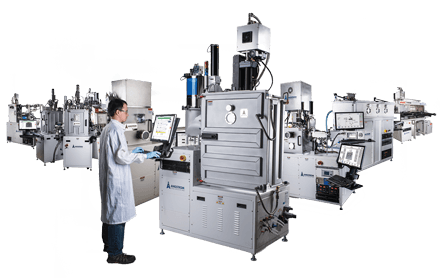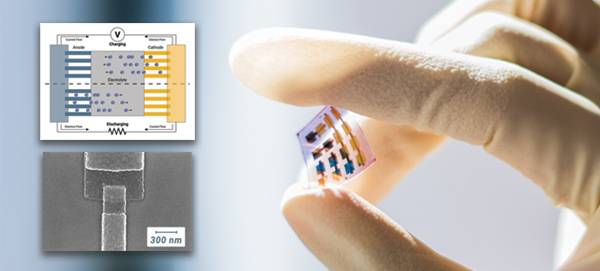Creating the Future:
7 fields that have seen significant advances during the 2010s thanks to Angstrom Engineering's partners.
We are entering not only a new year, but a new decade. The thin film deposition and vacuum equipment that we create is used everywhere on earth by scientists, researchers and industrialists to help bring about a sustainable, profitable, and more technologically advanced future. We're proud to create the tools used by the brightest among us to bring about this future, and before we hit the 20s, would like to take this opportunity to highlight 7 areas that have benefited from our partner's hard work over the past decade.
1. Display Technology and OLED
From the early days of OLED development at Princeton University and the University of Michigan, Angstrom Engineering has played, and continues to play a vital role in bringing this product to market. It's taken a few decades, but we're seeing many consumer products containing OLED technology, and Angstrom Engineering is proud to have played an important part in making that happen.
Beyond OLED, our partners are the leaders in the burgeoning mirco-LED development world, as well as transparent display research.
Three groups who use our equipment independently created Red, Green, and Blue perovskite based LEDs.
2. Perovskite Solar
Speaking of Perovskite, the 2010s could easily be described as the decade that saw this particular crystalline structured material really get off the ground. You can see the impressive progress in efficiency these cells have made (see NREL efficiency data), along with the tandem cells consisting of both perovskite and silicon. Our partners are represented throughout and on each step.
Perovskite's promise comes with significant challenges, however, and our partners are working hard to overcome them. Our partners at the University of Sheffield provide one potential solution, and our friends at NREL itself have done work to improve perovskites fragility issues. Henry Snaith, our partner from Oxford University, is working to improve perovskite's stability, and another group we support from Brown University is working to take the toxic lead out of their devices completely.
We have dozens of other partners who are using Angstrom PVD tools to work perovskite into an engine for a renewable energy future.
3. Quantum Technology
Einstein's observed 'spooky action at a distance' had its technological application manifest in Quantum computing, and the 2010s has seen superconducting information technology take a leap forward.
Josephson Junction fabrication using physical vapor deposition was a logical step for Angstrom Engineering as we had all the pieces to build the perfect qubit fabricator. As a result, many of our partners are now creating superconducting qubits that meet the highest standards.
We have quickly become the most trusted provider of this very specialized equipment (more information on Quantum Series here), providing both academic and commercial partners the means to create the most powerful information processing systems yet imagined. Our partners at the University of Waterloo, University of Southern California, and Hebrew University of Jerusalem are already making progress, and our commercial partners are also pushing the boundaries of what is possible.
4. Wearable & Edible Thin Films
Thin films provide creative scientists an outlet to discover novel applications, as they can be fabricated to be flexible, discreet, and even edible.
Dr. Katherine Mirica from Dartmouth weaved smart wool into textiles that can sense and filter dangerous gases. Dr. Chris Bettinger from Carnegie Mellon University has been pushing the boundaries of how electronics can be integrated into the human body, from brain implants, to non-toxic edible electronics.
Dr. Malte Gather from the University of St. Andrews made headlines in 2018 by creating some of the worlds lightest lasers that can be used in a contact lens with potential applications in security, biophotonics, and photomedicine. Dr. Trisha Andrew spent the decade innovating thin film textiles including heated gloves, woven solar panels, and smart pyjamas.
5. Medical Applications
Silver nanoparticles have long been observed to have antibacterial properties, but that's only the beginning of how thin films can help the medical community fight disease and injury.
Dr. Zhenan Bao at Stanford University works tirelessly on her projects, two of which include a stretchable, comfortable, and functional 'smart-skin' that can monitor any number of health metrics in patients. She also developed biodegradable sensors that can be implanted during reparative surgery to monitor strain on tendons and muscles.
Similarily, Professor Husam Alshareef at KAUST developed a wristband that can track health metrics during workouts, and Dr. Jennifer Dionne from Stanford University developed light-emitting nanoparticles with the ability to detect a single cancer cell in the body.
6. Photovoltaic (Solar) Advances
This decade has seen a significant uptick in interest for alternative sources of energy, with solar standing squarely on top. Besides the potential of perovskite, a mountain of research and innovation has allowed non-silicon based solar technologies to take a leap forward. Organic solar cells are more efficient, more robust, and a lot lighter than they were ten years ago.
Our longtime partner Dr. Stephen Forrest and his group have done quite a lot in this area, including breaking a few records, allowing electrons to travel further within the cell, and even proved organic PV's robustness.
Another development in solar is the innovation of transparent cells that harvest only the infrared and ultraviolet wavelengths, letting all the visible light pass through like any normal window. Our partner Dr. Richard Lunt has made significant progress with this. Here is a video of him speaking about it.
7. Space Exploration and Fundamental Science
While it is exciting to have Angstrom-made solar cells orbit the earth as they're tested on the international space station, it's also fascinating to see our equipment used to discover some of the fundamental questions of life on earth. For instance, Dr. Maikel Rheinstadter from McMcaster University uses our 'Planet Simulator' to determine how life first emerged in the universe. Dr. Mike Dixon from the University of Guelph uses our plant growth chambers to fine-tune food for future Martians, and Dr. Mike Daly from York University tests equipment in our space simulator chamber to aid in his work exploring planetary bodies like asteroid Bennu.
Beyond these fascinating extra-terrestrial applications of our vacuum vessels, our partners who utilize our systems to create thin films do pretty extraordinary things, like Dr. Gorodetsky from the University of California Irvine, who has has pushed the limits of what is possible in biomimicry, creating cephalopod inspired active camouflage systems via variable angle thin film deposition. There is also the Atwater group at Caltech, who just recently demonstrated the ability to manipulate matter with only photons.
With so many partners using our equipment to further the technological landscape of our civilization, it would be impossible to list all the incredible things being done. Needless to say, we're proud to work with these brilliant people every day, and play a part in advancing the technologies that will make our world better.
Happy New Decade to you and to our partners, who will no doubt do and create unbelievable things in the 20s.













